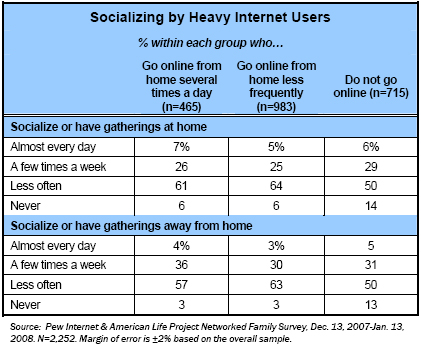Americans focus on family time and work time, often limiting the time they have available for leisure and other activities.
Our survey found that Americans try to balance work, family and leisure activities: for most, family time has the highest priority. A majority (55%) of all Americans reported that they are “very satisfied” with the amount of time they spend with their immediate families. Only 14% are not satisfied.
However, some Americans might have “bought” that family time by cutting back on other leisure activities. For example, only 35% are very satisfied with the amount of time they spend on hobbies or clubs, while 25% are not satisfied with their time spent on these activities.

Married couples are generally satisfied with the amount of time they are able to spend with family members, despite the growth in dual-income households and corresponding increase in time spent working. In all, 89% of married couples (which includes those with and without children) are “very” or “somewhat” satisfied with the amount of time they spend with family, compared with 79% of adults in non-married households.
A big part of this story is that despite multiple jobs and community opportunities, many families continue to spend much of their free time as a unit. Almost half (47%) of adults who live with a child or partner (everyone except for singles and non-married adults without children) say they spend most of their free time with household members. An additional 21% spend all of their free time with household members.
Being employed (whether full- or part-time) is highly associated with the level of a person’s satisfaction with his or her leisure pursuits. Those who are employed are less satisfied with the time they have available to spend with family, friends/relatives, engaging in hobbies or other activities, or just relaxing.

Most spouses and parents/children frequently eat dinner together.
Despite the demands of work, childcare, school and other activities, almost all (93%) of those adults who live with a partner or child have dinner with members of their household at least a few times per week, and more than half (56%) have dinner with members of their household every day. Just 7% of those who live with a partner or child have dinner with a family member a few times a month or less often.
Not surprisingly, individuals who must navigate the scheduling demands of employment are less able to have dinner with family members on a regular basis. Nevertheless, half of employed adults (51%) find time to have dinner every day with other household members, and 28% do so almost every day. Women have dinner slightly more frequently with family members then do men: 60% of women and 52% of men do so every day. Seniors are much more likely to have dinner with a family member every day than those in younger age groups: 72% of those aged 65+ who live with a spouse or child have dinner with a family member every day compared with 50% of 18-29 year olds, 53% of 30-49 year olds and 57% of 50-64 year olds. Employment likely plays an important role in each of these trends: seniors and women are relatively likely to be retired or not employed for pay, respectively.

Among married couples, technology ownership is highly correlated with employment (whether full or part time) by both spouses. Among married households where both spouses are employed, fully 90% own multiple cell phones (compared with 66% in married households where one or neither spouse is employed) and 58% have multiple computers (compared with 38% of other married couples). As a result, families with high levels of technology ownership have relatively lower levels of satisfaction with their time spent with family members. They are somewhat less likely to eat dinner daily with family members than those with lower levels of technology ownership—although this trend is more strongly linked with employment than with technology ownership per se. Moreover, the great majority of technology owners are like non-technology owners in eating dinner with family members at least several times per week.
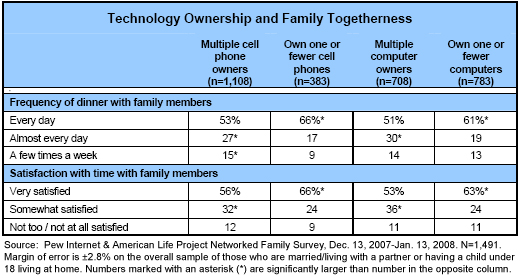
Television watching, though still a common household activity, has a greatly reduced importance among young adults.
Television remains a regular activity for most Americans: three-quarters (74%) of the adults we surveyed watch TV almost every day. Roughly six in ten young adults ages 18-29 (58%) say they watch TV almost every day, a notably lower percentage than the 72% to 89% of other age groups who watch TV on a near-daily basis. The older the age group, the higher the percentage that watches TV almost every day.
While the relatively small number of 18-29 year olds in our survey (and the extremely high rates of internet usage within this group) prevents a robust comparison of TV watching by young internet users and non-users, it is likely that internet use is a big part of the explanation of why young adults are the least likely to watch TV. Fully 85% of 18-29 year olds go online, 39% of young internet users go online from home multiple times throughout the day, and 29% say that they watch less TV as a result of the internet.

The act of watching TV is a social one for many viewers.
Among those who watch TV, more than half (52%) usually do so socially—with other people. This is particularly true for those living in multi-person households, 63% of whom usually watch TV with others. Not surprisingly, solitary TV viewing is especially prevalent in the context of single-person households: 86% of those who live alone and watch TV usually do so by themselves.
Notably, there is little relationship between the number of TVs in the household and whether or not individuals usually watch TV alone or with others. Two-thirds (65%) of adults from multi-person households with 1-2 TVs say they usually watch television with other people; this differs little from households with 3-4 TVs (61%) or those with five or more TVs (64%). Even in households where individuals have the ability to watch television alone, family members often choose to gather around the TV with family members.
Men and women watch TV with different family members.
Men and women are equally likely to watch TV and equally likely to say they watch it with others. However, they tend to watch with slightly different people: Men are more likely to watch TV with just a spouse or partner, while women are more likely to watch with just a child or children. Among those who watch TV with other people, 43% of men and 33% of women usually watch with a spouse or partner, while 4% of men and 12% of women usually watch with a child or children. Men (25%) and women (24%) are equally likely to watch TV with both a spouse and child/children and equally likely to watch television with other adults, whether inside or outside their immediate household: 23% of women and 20% of men do this.
Many families go online together.
People lean back in their easy chairs to passively watch a TV screen that is several yards away. It is easy for others to watch with them. By contrast, people lean forward in their desk chairs to actively interact with a computer screen that is only a foot or two away. The common mode of engagement is one person at one computer. Hence, the internet has more of a potential than TV to be a solitary activity, isolating household members from one another.
Nevertheless, many internet-using adults spend appreciable time at the computer with household members. Among home internet users who live with a spouse and child/children, 13% go online with another person on a daily basis, 9% do so almost every day, and 30% do so a few times a week. Another one-third (34%) do so less often. Thus, nearly nine in ten (87%) home internet users in married with children households go online with another person in the home at least occasionally.
As with TV, the presence of multiple computers in the household does not necessarily lead family members to be in their own isolated technological corners. Indeed, married with children households with multiple computers have as much (if not more) shared time online with others than single-computer households. We surmise that household members often look over each other’s shoulders to see what interesting things are on the other’s screen.
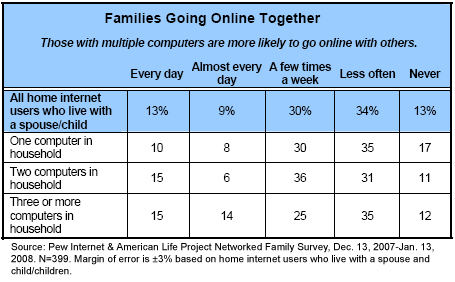
Many parents go online with their children. More than half of the parents (54%) who use the internet go online with another person a few times a week or more, compared with 36% of non-parents who go online and live in multi-person households. Additionally, 47% of the parents who go online with others say that they often go online with their child or children, and an additional 35% say they sometimes do so.
Men and women go online with different family members.
Men and women are equally likely to go online with others. However, just as with television viewing they tend to go online with different household members. Specifically, women are relatively more likely to go online with just their children, while men are more likely to go online with a spouse/partner and their children.
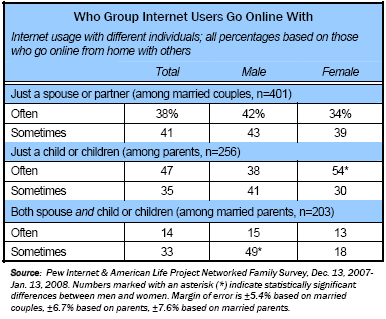
Socializing with others is a common activity, particularly among young adults.
One-quarter (26%) of all adults socialize or have gatherings at home with family or friends a few times a week, and 6% do so almost every day. Socializing away from home is also popular: One-third (32%) of adults socialize with family and friends away from home a few times a week, and 4% do so almost every day.
Young adults tend to socialize more frequently than older adults, both inside and outside of the home. Nearly half (47%) of 18-29 year olds socialize at home a few times a week or more, and a similar number (49%) socialize away from home at least a few times a week.
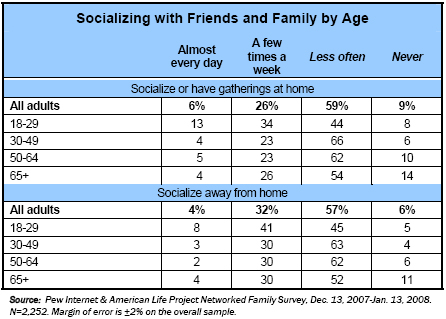
Men are more likely to socialize with their wives present.
Men and women are equally likely to socialize at home, although men are relatively more likely to socialize with their partners present than women are. Among partners or married couples who socialize at home, 62% of males say their spouse or partner is present all the time, compared with 54% of females. However, 29% of females do say that their spouse/partner is present most of the time when they socialize in the home. In total, 83% of both married men and married women who socialize at home say their partner is with them all or most of the time when they have in-home events.
Despite the binding ties and time constraints of domestic labor and childcare, women are no less likely than men to socialize away from home. However, men are more apt to involve their partner or spouse when they socialize outside the home. Among couples who socialize outside the home, 49% of males do so with their spouse or partner all the time, compared with 33% of female respondents. Women do socialize with their husbands outside the home, although with less frequency: 38% of women socialize with their spouse or partner most of the time (compared with 31% of men) and 13% involve their partner or spouse about half the time (compared with 8% of men).
Internet users socialize as often as non-internet users.
There have been continuing debates about whether internet use keeps people away from socializing or helps them to socialize. This debate will remain unanswered for the moment, as our survey shows little difference in the amount of socializing engaged in by either internet users or non-users: About one-third (31%) of internet users and 35% of non-users socialize with others at home a few times a week or more. Furthermore, more than one-third (37%) of internet users and 36% of non-users socialize with others away from home a few times a week or more. Indeed, even heavy home internet users—those who go online from home several times a day—are just as likely to socialize with other people (whether at home or elsewhere) as are less intense home internet users or those who do not go online at all.
